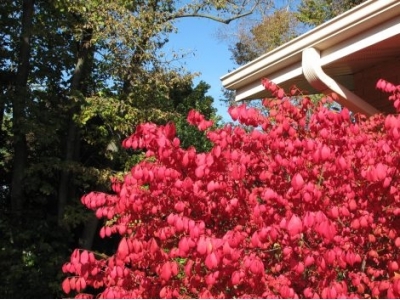How to Grow the Eastern Wahoo Shrub

Flaming fall foliage and an attractive multi-stemmed form make Burning Bush a popular choice for a hedge or shrub planting. Unfortunately, Euonymus alatus, the species most commonly grown in the U.S., is invasive throughout much of the East.
Easily spread by seed, this shrub has escaped into the wild, where it outcompetes native vegetation.
Enter the Eastern wahoo shrub (Euonymus atropurpureus). The Eastern wahoo shrub, also referred to as Burning Bush, has all the charm of its Asian cousin, but none of its aggressive personality. The two are almost identical, the only difference being that E. alatus has greenish-white flowers in the spring and the Eastern wahoo has maroon flowers. The Eastern wahoo has bright neon-red fall foliage and attractive reddish-purple fruits for the birds. The plant is easy to grow and needs almost no maintenance.
Planting the Eastern Wahoo
Native to woodland areas, the Eastern Wahoo tolerates most soil types and conditions. It grows best though in full sun and well-draining, but moist, soil. In shade, its color will be more subdued. Plant Eastern wahoo where it gets at least six hours of sunlight every day for best effect. Hardy in U.S. Department of Agriculture plant hardiness zones 3 to 7, the (unpruned) shrub can grow up to 15 feet tall and 10 feet wide, so plan accordingly when spacing it.
Eastern wahoo can be used as a specimen tree or planted in a hedge or mixed planting. After planting, water frequently so the soil stays moist 1 inch beneath the surface. Once the shrub is established, it can tolerate some drought, although growth is most vigorous with consistent moisture. Apply a 3 to 4 inch mulch of wood chips to help conserve moisture.
Eastern wahoo responds well to pruning. Prune it in late winter to early spring to remove old or dead branches, as well as those that rub against each other. You can also prune it back hard to control its size and growth. Cut the branches back to an outward facing bud. Leave the berries for the birds, but remember that all parts of the plant, including the fruit, are toxic to humans.
Eastern Wahoo Pests and Problems
Eastern wahoo rarely suffers serious damage from diseases and pests, but it is susceptible to powdery mildew and fungal spots. To minimize these problems, space Eastern wahoo so air circulates freely and avoid using overhead sprinklers. Soaker hoses seem to reduce disease problems. Remove and destroy all infected leaves. In severe cases, you can apply a fungicide labeled for treating powdery mildew or leaf spot.
The usual suspects infest Eastern wahoo – aphids, scales, mites and leafminers. The first three suck the sap from the leaves and stems with strong piercing mouth parts. They can be conquered with applications of insecticidal soap or oil. Spray both the tops and bottoms of the leaves and stems, covering them thoroughly. Make applications on an overcast day because bright sunlight can cause the oil to burn the leaves. Leafminers burrow through the leaves and young canes. Look for telltale holes at the base of branches to indicate the presence of leafminers. Cut infested stems back to ground level and discard or burn the branches.
When you buy Eastern wahoo, verify the botanical name -- Euonymus atropurpureus -- to ensure you’re getting a native plant and not the invasive Chinese or Japanese cultivars.
By Julie Christensen
Julie Christensen learned about gardening on her grandfather’s farm and mother’s vegetable garden in southern Idaho. Today, she lives and gardens on the high plains of Colorado. When she’s not digging in the dirt, Julie writes about food, education, parenting and gardening.
Có thể bạn quan tâm
 How to Grow Pampas Grass
How to Grow Pampas Grass Pampas grass (Cortaderia selloana), with its showy flowers and soft, billowing form, brings to mind Florida coastal regions and balmy climates.
 How to Grow a Prayer Plant
How to Grow a Prayer Plant With beautiful foliage and easy maintenance, the prayer plant (Marantaceae) is a lovely exotic house plant to enjoy indoors.
 How to Grow Angelonia
How to Grow Angelonia Angelonia is a cheerful little snapdragon flower for your landscape or containers. It comes in a variety of colors in shades ranging from whites and pinks